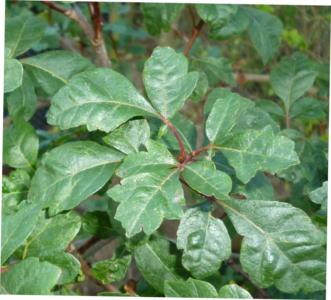Rhus trilobata pilosissima
(Rhus trilobata pilosissima)

Description
Rhus trilobata grows in many types of plant communities, such as the grasslands east of the Rocky Mountains, mountainous shrubland, pine, juniper, and fir forests, wetlands, oak woodlands, and chaparral. The plant is destroyed above ground but rarely killed by wildfire, and will readily sprout back up in burned areas. This Rhus species closely resembles other members of the genus that have leaves with three "leaflets" ("trifoliate" leaves). These include Rhus aromatica, native to eastern North America, and western poison-oak. The shape of the leaflets and the habit of the shrub make this species, like some other Rhus, resemble small-leafed oaks (Quercus). The Rhus trilobata leaves have a very strong scent when crushed. The aroma is medicinal or bitter, disagreeable enough to some to have gained the plant the name skunkbush. The leaves are green when new and turn orange and brown in the fall. The twigs are fuzzy when new, and turn sleek with age. The flowers, borne on small catkins ("short shoots"), are white or light yellow. Edible fruit, the plant yields hairy and slightly sticky red berries which have an aroma similar to limes and a very sour taste. The acidity comes from tannic and gallic acids.
Taxonomic tree:







